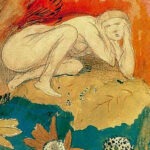
“So Now What?” A brief composite of convos with yoga teachers after #WAWADIA? workshops
September 25, 2016
“Am I Even Teaching Yoga Anymore?”
October 2, 2016One of the richest things for me about presenting on the post-extreme-asana paradigm with Diane Bruni is listening to her describe her former capacity to tolerate and then sublimate pain while she practiced.
“You get really good at directing your mind away from pain,” she said at a recent event, “or reframing it, or feeling the cortisol and endorphins you’re releasing as pleasure.”
As she’s talking, Diane will half-gesture at some of the things she used to do and teach. At one point she begins to lift her left leg up with both hands as though she were about to put it behind her head. She gets half-way, her spine begins to flex, and she quits, laughing a bit, and sets her leg down.
And then I’m flashing back to the first time I went to her studio, probably 2005. There she was in the Mysore class, rolling effortlessly through dozens of legs-behind-the-head postures with her eyes closed, in a deep trance.
I remember watching her back then and thinking to myself: she has something, she’s discovered something. She has a space of her own. She’s free.
I was so young. I did all the same things with sensation and pain that she did. I encountered it. It reminded me of other suffering in my life. I reframed it as different, productive, purifying, necessary.
Or – an illusion. A kind of excitement, masked by fear. The inseparability of pain and love felt familiar to me from somewhere. I could go into postures and feel the living crisis of my life in a way that I believed would give me mastery.
I also projected the same virtues I imagined in Dianne onto other teachers as well, especially hypermobile men onto whose bodies it was easier to project my own aspirations. How easy it was for me to conflate Diane’s postural trance with virtue, and to love something that would eventually tear her hip to shreds. From my existential stiffness I longed for the somatics of freedom, and the self-immolations of people like Bruni were the models I had.
The veneer of yoga philosophy, the sumptuous studio, the singing bowls — they all played into this strange conflation. We’re giving today’s talk in a studio with no incense burning, no murtis of deities, no droning harmonium. The studio complex houses treatments for massage and physiotherapy. It feels down-to-earth.
In a pause during Diane’s story, I butt in with a question. I say I notice her aping her former postures, and how it seems she’s stiffened right up.
“So how much has your body changed?”
“I’ve lost at least 50% of the mobility I had when I was addicted to extreme postures,” she says. “I have a normal range of motion now. I’ve never felt better.”
I could say the same thing. I’m stiff again, but it no longer feels like tension. It feels like I’m being held, like I have a silhouette, a boundary, like I can locate myself. I no longer want to be everywhere and nowhere. There’s no need to escape.
Then we took a break and Diane led us all through some movement things she’s discovered since branching out from the mat. She spoke about curved versus linear movement, roundness versus angularity. She described the infinite space you can within normal movement, if you can discipline yourself away from extremes.
She talked about all the feelings we miss out on when we’re at the end of things: all the in-between feelings, so vast and sometimes scary.
I’m left with the question of what wounds we carried within us that pushed us to those extremes, that made us feel like we might be finally healed if we went right to the edge of destruction.